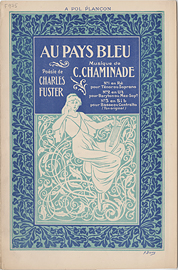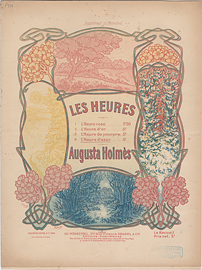[T]he works of a woman artist, as admirably talented and marvelously hard-working as Mme Cécile Chaminade, do more for the real emancipation of women and are more threatening to the lengthy autonomy of men than all the talking about it.
- Anon., “Mme Cécile Simon, Mme. Mel Bonis, Mme Cécile Chaminade (Conférence posthume d’Armand Silvestre)," La Française, August 7, 1901 (cited in Harris, 2014, 32).
The decorative art-nouveau cover pages of these final selections capture the shift to the twentieth century, a new era promising increasingly progressive social conventions and rights for women. At the Schola Cantorum, Vincent d’Indy admitted women on equal terms with men and employed female professors; in 1904, Hélène Fleury won the deuxième Second Grand Prix and, in 1913, Lili Boulanger (1893–1918) won the Grand Prix de Rome; women’s compositions appeared more frequently in prestigious concerts series, such as the Société Nationale and the Concerts Colonne; Princesse Armande de Polignac became the first woman to conduct professional orchestras; and, in 1913, Cécile Chaminade (1857–1944) became the first female composer admitted to the Légion d’honneur.
Although women benefitted from improved access to musical institutions, they were frequently beleaguered by the press. In reviews of women composers, critics grappled with gendered notions of compositional aesthetics and the figure of the author. Women adopted various strategies for negotiating their career and public image within complex cultural and gender politics. Augusta Holmès (1848–1903), who initially promoted her music in salons, moved decisively into the public spotlight with patriotic works such as her Ode triomphale for the Centennial at the 1889 Exposition Universelle; she cultivated a singular image as a “virile” patriot. In contrast, Cécile Chaminade, after composing large-scale instrumental pieces, including her symphonie dramatique, Les amazones (1888), turned toward more intimate works by the 1890s: piano and chamber music, and mélodies. Her capitalization on the salon music market brought her international recognition, particularly in the United States, where she embarked on an ambitious tour in 1908. A composer and music publisher, Jane Vieu (1871–1955) wrote over 100 works, including operas, piano and chamber music, and songs. She insisted, “What is important for a woman is to work. So let’s work” (Rivière, 1902).



